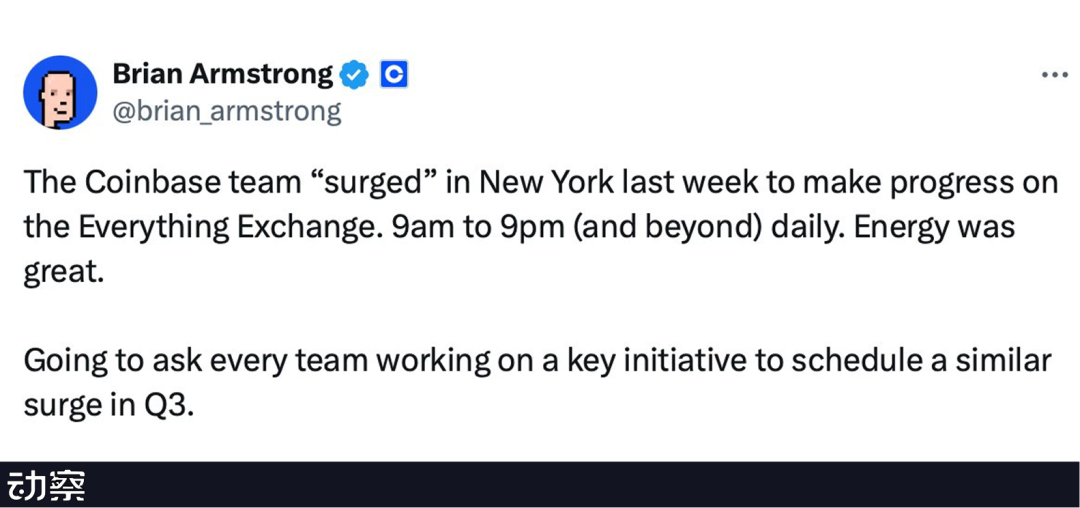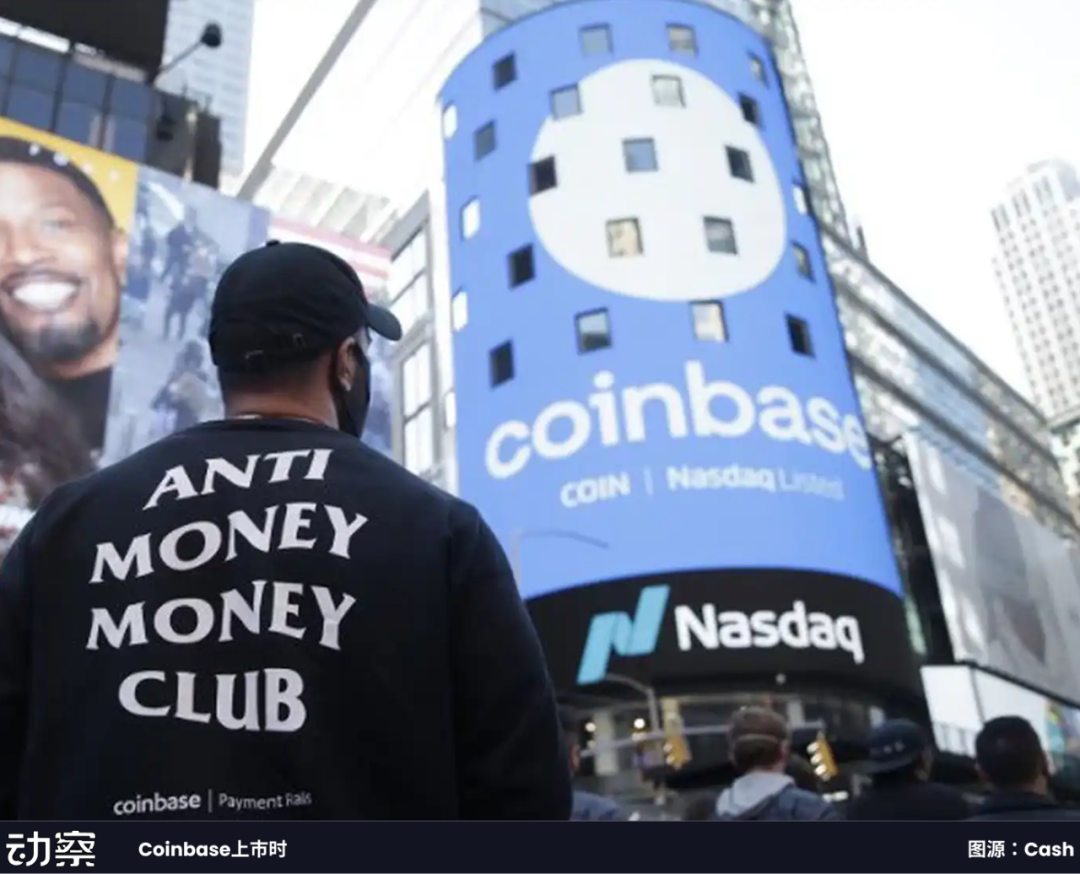Original author: Lin Wanwan EeeVee
Original source: Beating
Coinbase has adopted the Chinese 996 system.
CEO Armstrong boasted on Twitter: The New York team has assembled and is working overtime to develop Everything Exchange, from 9 a.m. to 9 p.m. every day, or even later.

What was initially a simple post sparked a fierce split in the comment section. European and American netizens criticized it as a pathological overwork culture, while Asian netizens downplayed it, saying, "It's normal in China, nothing to brag about."
However, 996 is just a superficial phenomenon, behind which lies Coinbase’s real anxiety.
In Q1 of 2025, Coinbase's net profit plummeted 94% year-on-year, and trading revenue declined across the board; the net profit in the Q2 financial report was US$1.4 billion, which seems high at first glance, but this figure is more from the book gain of Circle investment rather than its own blood-making.
Therefore, Coinbase's real spot trading business is still collapsing, and the combination of ETFs, on-chain transactions and Robinhood has made this former "compliance king" appear increasingly passive.
This is not a dilemma unique to Coinbase. Exchanges are all seeking a more competitive 996 and more profitable transformation.
Because the question on the table of Coinbase is becoming more and more acute: How long can the golden age of cryptocurrency exchanges last?
From Washington to Wall Street
As early as five or six years ago, Coinbase understood that if it wanted to go further, the exchange had to adhere to the four words of legality and compliance.
One afternoon in 2019, Brian Armstrong walked into Capitol Hill for the first time. Slides in hand, he prepared to explain encryption to lawmakers like an entrepreneur to investors.
But the question that came up was so funny that he didn't know whether to laugh or cry. "Oh, so you're the CEO of Bitcoin?"
Someone else asked, “Is this a video game?”
At that moment, he realized that this was not a debate, but a "cross-species communication."
In fact, this isn't the first time Armstrong has been forced to confront misunderstandings. Before Coinbase went public, he repeatedly recalled the lonely moments of being a founder: in the years when cryptocurrencies were still a gray area, few banks were willing to work with Coinbase, and even basic payroll and corporate accounts became a challenge.
He admitted that every negotiation at that time was like "begging" for a way out from the traditional financial system.
In the early days of his business, Armstrong naively believed that as long as he abided by the law, he could focus on product development. But as Coinbase grew, he discovered that regulatory ambiguity was a weapon in itself.
SEC Chairman Gensler used "uncertainty" as an excuse to fire at the entire industry; Senator Elizabeth Warren even tried to portray encryption as "financial drugs."
This experience made him realize the importance of compliance earlier and more deeply than many people imagined. Compared to many similar companies in the industry that chase traffic, Coinbase chose a seemingly slower path from the outset: proactively applying for licenses, implementing KYC/AML, and repeatedly communicating with regulators.
Armstrong then realized that if you don't take the initiative to shape the rules, you can only wait for others to make the final judgment on you.
So, he began to change his approach. Besides continuing to fly to Washington to serve as an "educator," he formed a policy team, funded the creation of StandWithCrypto.org, created a "pro-crypto index" for each member of Congress, and even invested in the super PAC Fairshake.
The 2024 US election brought crypto voters to the forefront for the first time. Anti-crypto lawmakers were voted out, while new pro-crypto figures were elected. Washington finally realized: 50 million Americans had used crypto wallets. This wasn't just a fringe issue, but a rigged voting machine.
On Wall Street, Armstrong plays a different card: compliance.
On the eve of its 2021 listing, Armstrong mentioned in a media interview that Coinbase was able to knock on the door of Nasdaq not only because of its business achievements, but also because it was ahead in terms of compliance.
This is also the true meaning of IPO in his eyes. It is not only a financing, but also a "rectification", a milestone that brings the encryption industry from the fringe to the mainstream. 
In 2025, he pushed for the passage of the Genius Act, which mandated that stablecoins be 100% backed by cash or U.S. Treasury bonds. This was not only a legislative victory but also a defensive moat for Coinbase. As a Circle shareholder, it received a share of the interest income from USDC. For the entire year of 2024, Circle's reserve interest income was approximately $1.68 billion, of which approximately $910 million was paid to Coinbase.
Stablecoins have become a story that both Wall Street and Congress buy into: for the government, it continues the dollar's hegemony; for capital, it provides stable cash flow.
In this way, Coinbase has completed a transformation. In Washington, it is a lobbying machine that shapes the rules; on Wall Street, it is a compliance gateway that connects capital.
Armstrong once said, “If you become big, the government will care about you even if you don’t.”
This sentence also serves as a footnote. Coinbase's new battlefield has already surpassed the exchange itself.
The "CEX Crisis" in Financial Reports
Being legal and compliant alone is far from enough for an exchange.
Although it is still one of the world's largest cryptocurrency trading platforms, Coinbase's financial report for the first half of 2025 is full of anxiety.
First-quarter revenue reached $2 billion, a 24.2% year-on-year increase, which sounds respectable. However, against the backdrop of a 94% year-on-year plunge in net profit, this figure almost loses its meaning. The $66 million in net profit not only fell far short of market expectations, but also gave investors their first real indication that the old model of centralized exchanges is collapsing.
The decline in spot trading revenue was particularly noticeable.
Institutional trading declined by 30% year-over-year, while retail trading also decreased by 19%. This is undoubtedly due to a cooling market. Since 2025, the volatility of Bitcoin and Ethereum has plummeted, transforming the market from a roller coaster to a flattened path. Both institutional and retail investors have lost the urge to frequently enter and exit the market.
But the deeper pressure comes from the restructuring of the market structure.
The launch of ETFs has directly rewritten the investor journey. Following Bitcoin, Ethereum, Solana, and XRP have all applied for ETFs. These were originally core trading currencies on Coinbase.
Compared with the 0.5% transaction fee of CEX, the annualized management fee of 0.1%-0.5% of ETF seems much cheaper, and funds naturally began to flow to Wall Street.
At the same time, the wealth-creating effect on the chain keeps more users on the chain.
The meme and DeFi craze has shaped new habits among native investors: CEXs are no longer trading venues, but rather a "cross-chain bridge for deposits and withdrawals" and a "temporary wallet for stablecoins." The rise of decentralized derivatives has further accelerated the outflow of funds.
New platforms like Hyperliquid, with their flexible listing mechanisms, higher leverage, and superior user experience, have quickly attracted traders from heavily regulated regions like the United States. In the eyes of these users, Coinbase's "conventional" approach has become a constraint.
The more deadly competition comes from the heartland of traditional finance.
Robinhood has announced a full-scale entry into the crypto market, targeting Coinbase's most valuable young retail investor base. For these investors, Robinhood offers a more familiar interface, lower fees, and a seamless one-stop experience for both US stocks and cryptocurrencies. For large investors, Robinhood's perceived brokerage aura makes it even more attractive than Coinbase.
This multiple squeeze was starkly magnified in the second-quarter 2025 financial report. Coinbase disclosed that its total revenue for the quarter was approximately $1.5 billion, a 26% decrease from the previous quarter. Its GAAP net profit was a whopping $1.4 billion, which, while impressive at first glance, was largely due to paper gains from Circle investments and crypto asset holdings.
Once these one-time factors are removed, adjusted net profit is only $33 million. More importantly, core spot trading revenue was only $764 million, a 39% year-on-year decline.
The books are bustling, but reality is bleak. Coinbase's profits no longer rely on trading, but on stablecoin profit sharing. This is a harsh report card, and perhaps also a sign of the end of a golden age.
When trading platforms no longer rely on trading business
Faced with difficulties, Coinbase put forward a new vision.
In a recent interview, Coinbase CEO Brian Armstrong put forward a plan: all assets will eventually be put on the chain, so we need to create an Everything Exchange.
In his eyes, encryption is not an isolated industry, but a technology that can upgrade the entire financial system.
Armstrong specifically mentioned the current state of the US stock market: Today, if an Argentinian wants to open a US brokerage account, the financial threshold is extremely high. For ordinary investors in most countries, US securities are almost a "rich-only market."
But if stocks are tokenized and moved to the chain, this barrier can be broken down, allowing anyone in the world to buy and sell U.S. assets at any time.
Being on-chain also means more possibilities: 24-hour uninterrupted trading, support for fractional share trading, and even the design of new governance logic, such as "only shareholders who have held shares for more than one year can vote" to encourage long-term investors. 
In his vision, Coinbase is no longer just a platform for matching transactions, but a "universal exchange" that can handle all assets on the chain, an open, inclusive, and around-the-clock financial operating system.
For this reason, Coinbase began to take a series of actions to align with Armstrong's vision: in the past six months, it has acquired Spindl, Iron Fish, Liquifi and Deribit.
The first three companies serve the Base chain: Spindl provides an on-chain advertising stack, allowing developers to directly acquire users; Iron Fish brings a zero-knowledge proof team to build a privacy module on Base; Liquifi provides token management and compliance services, and plans to integrate with Coinbase Prime to facilitate institutions and RWA projects.
The three work together to lower the threshold for developers on Base and create a complete tool stack.
The most significant acquisition was Deribit. Contract trading is more stable and profitable than spot trading, but Coinbase has long been constrained by US regulations and has been absent from the market. The $2.9 billion acquisition of Deribit gave Coinbase a leading options market share and a large institutional clientele.
Less than a month after the merger was completed, Coinbase launched perpetual contracts under CFTC supervision, which was equivalent to "seamlessly taking over" Deribit's capabilities.
If the acquisition is a violent breakthrough of Coinbase's transaction revenue ceiling, then its ongoing business expansion is a deeper reshaping of its identity.
It focuses on the "heavy lifting": stablecoins, wallets, public blockchains, and institutional services. These seemingly basic pieces are now outlining a new Coinbase: not just an exchange, but a Web 3 version of Apple + Visa + AWS.
The first step was a stablecoin. Coinbase didn't directly issue USDC, but through profit sharing with Circle, it pocketed a significant interest rate differential. This created a conflict: Circle was dissatisfied with its "high returns but low contributions." Coinbase realized it had to expand USDC into more scenarios.
They began subsidizing USDC deposits and partnered with Shopify to launch a payment API, embedding the stablecoin into real-world checkout counters and financial systems, making USDC a true payment tool. This was also driven by a16z, who viewed stablecoins as the "TCP/IP of internet finance."
The second step is the wallet. Coinbase Wallet has been upgraded to a smart wallet, eliminating the need for mnemonics and allowing one-click creation. It also integrates NFT display, on-chain identity, and social features. It even integrates with Lens and Farcaster, turning the wallet into a "crypto social network."
Once a user's funds, identity, and social connections are tied together, the wallet becomes Coinbase's traffic gateway. Combined with the Base Chain, this system becomes increasingly similar to iOS: the wallet is the App Store, Base is the operating system, and USDC is Apple Pay. Coinbase no longer relies on market fluctuations to profit, but instead extracts "on-chain taxes" from the cycle of "identity + funds + social connections."
The third step is institutional access. Coinbase Prime already serves over 500 funds and asset management firms and is the primary platform for USDC custody. If assets like RWAs and STOs truly become available on-chain on a large scale, Prime could become the Goldman Sachs and BlackRock of blockchains, providing a stable source of revenue.
Unlike most platforms, Coinbase no longer relies on retail investor sentiment and trading enthusiasm. Instead, it aims to control underlying infrastructure: the funding portal (USDC), account portal (Wallet), trading portal (Base), and institutional portal (Prime).
The future of Coinbase is not a bustling trading hall, but a "universal exchange," a financial operating system that can handle all assets and operate around the clock.
The role of the settlement layer gives it the opportunity to transcend short-term noise and volatility, making encryption the underlying layer, turning transactions into public services, and turning users into network nodes. This may be the next Coinbase that Armstrong envisions.
"996" sweeps exchanges
There is never a shortage of "volumes" in the exchange.
In the past, the competition was all about who could list their tokens faster, who could offer the most generous subsidies, or who could offer the lowest transaction fees. That was a lively, superficial competition: once the traffic came, the profits followed.
Today's market dynamics are completely different. ETFs have taken away incremental growth from major cryptocurrencies, on-chain DeFi and memes have kept native users on-chain, and brokerages like Robinhood have captured a new generation of retail investors. With the market pie shrinking, relying solely on spot trading can no longer sustain a platform's future.
As a result, the methods of expansion were forced to evolve. OKX focused on wallets, hoping to lock in users through access points; Binance focused on the ecosystem, converting alpha incentives into traffic reflow; and Coinbase focused on infrastructure, using mergers and acquisitions, stablecoins, wallets, and institutional services to build a framework for a "universal exchange."
This is a heavier, more complex 996. It's not a short-term promotional war, but a long-term infrastructure overtime effort. They're no longer competing for short-term transaction volumes, but rather for control of capital access, identity portals, and clearing networks for the next decade.
In the past, the competition was about grabbing land and competing for traffic; now, the competition is about building a strong fortress and fighting a stupid battle.
Exchanges all understand that the traffic bonanza is over. The key to success for exchanges is no longer in the ups and downs of spot contracts, but in who can take the first move on the ecosystem chessboard.
- 核心观点:Coinbase面临核心业务萎缩,转型万能交易所。
- 关键要素:
- 现货交易收入同比暴跌39%。
- ETF和链上交易分流用户资金。
- 通过收购和稳定币分润寻求新增长。
- 市场影响:交易所竞争转向基础设施和生态构建。
- 时效性标注:中期影响。



